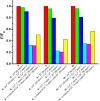Incorporating a piperidinyl group in the fluorophore extends the fluorescence lifetime of click-derived cyclam-naphthalimide conjugates
- PMID: 24983863
- PMCID: PMC4077572
- DOI: 10.1371/journal.pone.0100761
Incorporating a piperidinyl group in the fluorophore extends the fluorescence lifetime of click-derived cyclam-naphthalimide conjugates
Abstract
Ligands incorporating a tetraazamacrocycle receptor, a 'click'-derived triazole and a 1,8-naphthalimide fluorophore have proven utility as probes for metal ions. Three new cyclam-based molecular probes are reported, in which a piperidinyl group has been introduced at the 4-position of the naphthalimide fluorophore. These compounds have been synthesized using the copper(I)-catalyzed azide-alkyne Huisgen cycloaddition and their photophysical properties studied in detail. The alkylamino group induces the expected red-shift in absorption and emission spectra relative to the simple naphthalimide derivatives and gives rise to extended fluorescence lifetimes in aqueous buffer. The photophysical properties of these systems are shown to be highly solvent-dependent. Screening the fluorescence responses of the new conjugates to a wide variety of metal ions reveals significant and selective fluorescence quenching in the presence of copper(II), yet no fluorescence enhancement with zinc(II) as observed previously for the simple naphthalimide derivatives. Reasons for this different behaviour are proposed. Cytotoxicity testing shows that these new cyclam-triazole-dye conjugates display little or no toxicity against either DLD-1 colon carcinoma cells or MDA-MB-231 breast carcinoma cells, suggesting a potential role for these and related systems in biological sensing applications.
Conflict of interest statement
Figures





Similar articles
-
Synthesis and Evaluation of 1,8-Disubstituted-Cyclam/Naphthalimide Conjugates as Probes for Metal Ions.ChemistryOpen. 2016 Aug 3;5(4):375-85. doi: 10.1002/open.201600010. eCollection 2016 Aug. ChemistryOpen. 2016. PMID: 27547648 Free PMC article.
-
Recent Advances in Macrocyclic Fluorescent Probes for Ion Sensing.Molecules. 2017 Jan 25;22(2):200. doi: 10.3390/molecules22020200. Molecules. 2017. PMID: 28125069 Free PMC article. Review.
-
A synthetically simple, click-generated cyclam-based zinc(II) sensor.Inorg Chem. 2009 Jan 5;48(1):319-24. doi: 10.1021/ic8017634. Inorg Chem. 2009. PMID: 19053845
-
Fluorophore-Assisted Click Chemistry through Copper(I) Complexation.Biomolecules. 2020 Apr 16;10(4):619. doi: 10.3390/biom10040619. Biomolecules. 2020. PMID: 32316290 Free PMC article.
-
[Development of Fluorescence Sensing Mechanism for Cell Functional Analysis].Yakugaku Zasshi. 2016;136(1):3-7. doi: 10.1248/yakushi.15-00225-1. Yakugaku Zasshi. 2016. PMID: 26725660 Review. Japanese.
Cited by
-
A direct method for the N-tetraalkylation of azamacrocycles.Beilstein J Org Chem. 2016 Nov 18;12:2457-2461. doi: 10.3762/bjoc.12.239. eCollection 2016. Beilstein J Org Chem. 2016. PMID: 28144313 Free PMC article.
-
Review on Recent Advances in Metal Ions Sensing Using Different Fluorescent Probes.J Fluoresc. 2018 Jul;28(4):999-1021. doi: 10.1007/s10895-018-2263-y. Epub 2018 Jul 14. J Fluoresc. 2018. PMID: 30008059 Review.
-
Efficient deprotection of F-BODIPY derivatives: removal of BF2 using Brønsted acids.Beilstein J Org Chem. 2015 Jan 9;11:37-41. doi: 10.3762/bjoc.11.6. eCollection 2015. Beilstein J Org Chem. 2015. PMID: 25670990 Free PMC article.
-
Synthesis and Evaluation of 1,8-Disubstituted-Cyclam/Naphthalimide Conjugates as Probes for Metal Ions.ChemistryOpen. 2016 Aug 3;5(4):375-85. doi: 10.1002/open.201600010. eCollection 2016 Aug. ChemistryOpen. 2016. PMID: 27547648 Free PMC article.
-
Recent Advances in Macrocyclic Fluorescent Probes for Ion Sensing.Molecules. 2017 Jan 25;22(2):200. doi: 10.3390/molecules22020200. Molecules. 2017. PMID: 28125069 Free PMC article. Review.
References
-
- Yang Y, Zhao Q, Feng W, Li F (2013) Luminescent chemodosimeters for bioimaging. Chem Rev 113: 192–270. - PubMed
-
- Grabchev I, Staneva D, Betcheva R (2012) Fluorescent dendrimers as sensors for biologically important metal cations. Curr Med Chem 19: 4976–4983. - PubMed
-
- Mbatia HW, Burdette SC (2012) Photochemical tools for studying metal ion signaling and homeostasis. Biochemistry 51: 7212–7224. - PubMed
Publication types
MeSH terms
Substances
LinkOut - more resources
Full Text Sources
Other Literature Sources
Miscellaneous

